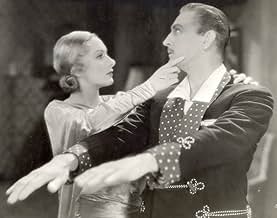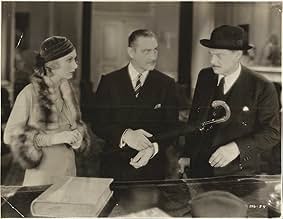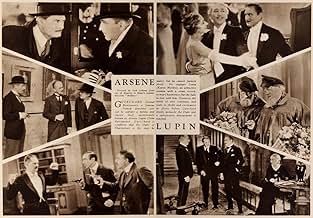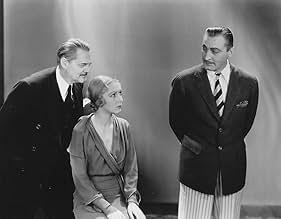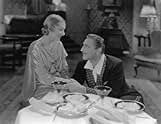अपनी भाषा में प्लॉट जोड़ेंA detective is tasked to capture an elusive thief called Arsene Lupin.A detective is tasked to capture an elusive thief called Arsene Lupin.A detective is tasked to capture an elusive thief called Arsene Lupin.
- पुरस्कार
- कुल 3 जीत
- Laurent
- (as James Mack)
- Louvre Tour Guide
- (बिना क्रेडिट के)
- Party Guest
- (बिना क्रेडिट के)
- Louvre Guard
- (बिना क्रेडिट के)
- Party Guest
- (बिना क्रेडिट के)
- Gendarme
- (बिना क्रेडिट के)
- Mother at the Louvre
- (बिना क्रेडिट के)
- Party Guest
- (बिना क्रेडिट के)
- Detective
- (बिना क्रेडिट के)
फ़ीचर्ड समीक्षाएं
Like Ronald Colman and David Niven in Raffles, Barrymore is as debonair and charming as they playing the titled thief. His Clark Kent persona is the Duke of Charace, but when he's working he's Arsene Lupin. He even sends notes to the police signed Arsene Lupin.
The man assigned to catching the notorious Arsene Lupin is Inspector Lionel Barrymore who has a good reputation. But Lupin proves to be a bedeviller. Never mind say Lionel's superiors, your job is on the line if you don't get him within a week. They make no bones about it, he robs the rich and the rich pay our taxes.
The party of skinflint old nobleman Tully Marshall is the target and it's a game of cat and mouse between the Barrymore brothers.. Lionel brings in reinforcements with the beautiful Karen Morley, but John is up to just about anything Lionel can muster.
Arsene Lupin is old fashioned, but the brothers are incredible to watch even after over 80 years. It's worth a look.
KAREN MORLEY is the attractive blonde who is supposed to be helping Lionel get the goods on the thief--but, unfortunately, she's no help at all when she falls hopelessly in love with the charming scoundrel.
So much about the film, where much of the action takes place on a country estate with wealthy people in attendance, reminds me of the David Niven/Olivia de Havilland film about the Scotland Yard thief RAFFLES. Barrymore plays the role with the same effortless charm that Niven adapted for his Raffles, the man who kept authorities baffled with a string of jewel robberies.
TCM is showing a good print of the film and while some of the dialog leaves a lot to be desired, it's a good example of an early sound film that still holds up today. Interior sets of the country estate are expensively mounted and it's obvious this was designed as a major film, not a programmer, despite the slight story.
Lionel hams it up considerably throughout, but John is more effective in his underplayed role.
Including 1932's 'Arsene Lupin'. If anybody loves or at least appreciates John and Lionel Barrymore individually they should find much to enjoy, and even more so seeing them together. If anybody loves the character of Lupin, they should find a lot to like about 'Arsene Lupin' (am not saying that for definite and it is not going to be the case for all perhaps). It serves as a very introduction to him if one has little prior knowledge of Lupin and is intrigued by it for appreciating early talkies and the Barrymore brothers. As far as early talkies go, 'Arsene Lupin' is not one of the best but it is not one of the worst either (nowhere near close, personally put it somewhere around high middle).
What really makes 'Arsene Lupin' so worth watching is the Barrymore brothers. Generally have a personal preference for Lionel ever since seeing his unforgettable Potter from 'It's a Wonderful Life' for the first time, and he is clearly having enormous fun here so it was easy to enjoy him. To me though John as Lupin comes off even better, suave, amusing and charming all at once and he is also a lot less theatrical here than he was prone to around this period. Their chemistry is dynamite. Karen Morley more than holds her own and is endearing, love her alluring chemistry with John and she even gets some risque material. Tully Marshall stands out too with great comic timing without being too buffoonish. The whole cast is good.
Likewise with the adroit direction from dependable Jack Conway, have not liked every film of his but he did do some very good ones and 'Arsene Lupin' is one of them. He never seemed ill at ease with the material or at odds with it. The film looks attractive and full of class, especially the photography, and the score has a sense of adventure and tension orchestrated beautifully. There is some nice witty dialogue throughout, it never gets vulgar and the sophistication shines. The story is always involving and has an authentic atmosphere, the ending is thrilling.
Really not much here to criticise, though there are times where the relative infancy of early talkies is betrayed in some staid pacing every now and again, bogged down by not always necessary caption cards, and padding.
Overall, very entertaining. 8/10
However, the film under review – which I had first acquired via a TV-to- VHS-to-DVD conversion of poor quality, but which I eventually upgraded (albeit still culled from a TCM screening) – remains perhaps the most popular rendition of this debonair figure; by the way, I also have in my collection its direct but-as-yet unwatched 1938 sequel ARSENE LUPIN RETURNS. Incidentally, such gentlemen crooks were a regular feature of pulp fiction (notably the similarly much-filmed "Raffles": I own versions of it dating from 1917 – starring, as here, John Barrymore – 1925, 1930 – alas, only a TV-to-VHS copy – and 1939!) until they made way for more ruthless and ambitious criminal masterminds such as Fantomas and Dr. Mabuse.
Anyway, this classy production – best-known for first teaming John with his elder brother Lionel (they would appear together 5 times in 2 years, on one of which they were even joined by sister Ethel!) – is most enjoyable, with a plot which has since become a cliché: the protagonist's duality (hiding under an air of respectability and, at one point, the guise of an aged flower-seller to pull off a daring 'job' at the Louvre); the analogous deception by the woman in his life (or, more precisely, the one he finds in his bed – a delightfully racy scene for an MGM picture but, then, this was a "Pre-Code" release – during a reception!); Lupin's tenacious, but ultimately sympathetic, antagonist (whose physical attributes – including a prominent limp – actually fit the description of the 'villain' as given by an eye-witness!); the ultra-modern gadgets (a safe without the proverbial combination but 'armed' with an electrical charge), etc.
John Barrymore's famed good looks ("The Great Profile" was 50 at the time) and up-till-then infrequently-tapped comic timing (though he would increasingly come to rely upon it for the rest of his career!) make him, respectively, ideal casting and a pleasure to watch; for what it is worth, I have as many as 23 titles of his still to go through even if only 4 fall into my current exercise of movie viewing based on all-time best polls and the higher ratings bestowed by Leslie Halliwell and Leonard Maltin!
John & Lionel Barrymore costarred together for the first time in a motion picture in this intriguing crime drama. Alike and yet so different, they are the perfect counterpoint to each other. John plays his role with suave sophistication (when not in disguise) and Lionel is earthy & common in his portrayal, each obviously having a wonderful time trying to out act the other. Helped by a generous script, the outcome is pretty much a draw, with the viewer the clear winner.
Although upstaged by the two male stars, Karen Morley is intriguing as the mystery woman John finds naked in his bed. Tully Marshall gives a colorful performance as a silly nobleman with much to lose to the master criminal. Henry Armetta & George Davis are very enjoyable as two seriously inept security guards. John Miljan provides a sturdy presence in his small role as the police prefect.
Movie mavens will recognize an uncredited Mischa Auer as a guide in the Louvre during the climactic scene dealing with an attempted heist of the Mona Lisa.
क्या आपको पता है
- ट्रिवियाThe selling point at the time of the film's release was the first joint screen appearance of brothers John and Lionel Barrymore. Their chemistry was so strong that they would be co-assigned four more times by MGM in the next two years, in Grand Hotel (1932), Rasputin and the Empress (1932), Night Flight (1933), and Dinner at Eight (1933), the last of which gave them no scenes together. Rasputin and the Empress (1932) marked the only time that all three Barrymore siblings - Lionel, Ethel and John - appeared in the same film.
- गूफ़Lupin steals the Mona Lisa by wrapping the canvas around his umbrella. The Mona Lisa is painted on a wood panel.
- भाव
Arsène Lupin: [fetching Sonia's evening gown from the maid and holding it up to admire it] Well, here we are. It's very nice! It's a little naughty. It's very ni - Do you think your father the general would approve of this?
Sonia: My father the general always said that a gentleman was a man who never went to bed with his spurs on.
Arsène Lupin: Isn't that a pity. I'm so fond of horses. I could give up riding...?
Sonia: Give me that dress!
Arsène Lupin: You can't get into it alone
Sonia: The maid will help me.
Arsène Lupin: The maid? I know more about unhooking than any maid in Paris.
Sonia: Yes, but I want this one hooked.
[she reaches for the dress, which he holds out of reach]
Sonia: I'm going to stay right here in this bed until you leave this room!
[Chamerace walks over to the window and prepares to toss out the dress]
Sonia: What are you doing?
Arsène Lupin: Well, if you're going to stay in bed you won't need the dress.
- क्रेज़ी क्रेडिटThe opening title doesn't list the Barrymores separately, but instead as a pair, "John and Lionel Barrymore."
- कनेक्शनFeatured in Biography: The Barrymores (2002)
टॉप पसंद
विवरण
बॉक्स ऑफ़िस
- बजट
- $4,33,000(अनुमानित)
- चलने की अवधि
- 1 घं 24 मि(84 min)
- रंग
- पक्ष अनुपात
- 1.37 : 1



